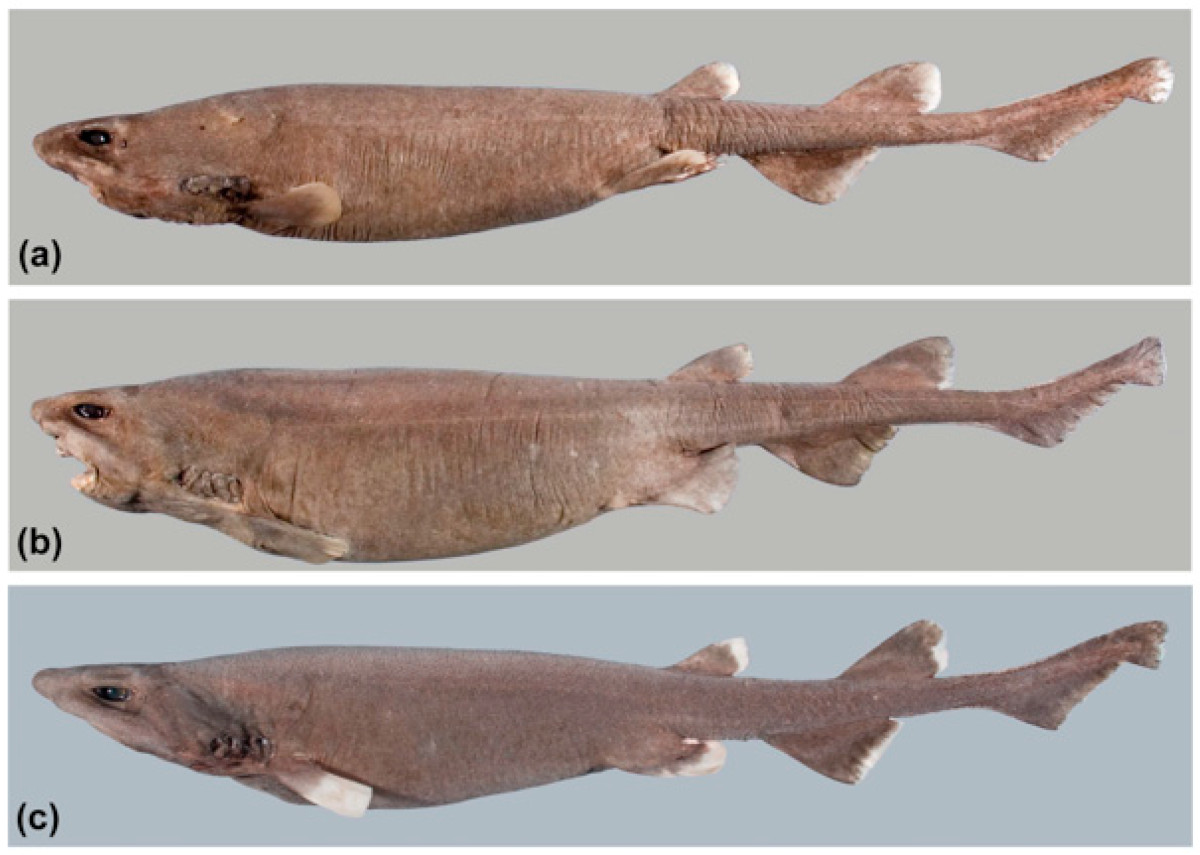Dichichthys satoi
White, Stewart, O’Neill & Naylor, 2024
Roughback Bristle Shark
Classification: Elasmobranchii Carcharhiniformes Dichichthyidae
Reference of the original description
Dichichthyidae, a New Family of Deepwater Sharks (Carcharhiniformes) from the Indo–West Pacific, with Description of a New Species. Fishes, 9, Article 121
Dichichthyidae, a New Family of Deepwater Sharks (Carcharhiniformes) from the Indo–West Pacific, with Description of a New Species. Fishes, 9, Article 121
Types
Dichichthys satoi
Holotype: NMNZ: P.042517; Paratype: AIM: MA73694; CSIRO: H 9287-01; NMNZ: P.017655; NMNZ: P.020141; NMNZ: P.025376; NMNZ: P.042524; NMNZ: P.044582; NMNZ: P.044583; NMNZ: P.045528; NMNZ: P.047247; NMNZ: P.057059; NMNZ: P.062238; NMNZ: P.062313;
Dichichthys satoi
Holotype: NMNZ: P.042517; Paratype: AIM: MA73694; CSIRO: H 9287-01; NMNZ: P.017655; NMNZ: P.020141; NMNZ: P.025376; NMNZ: P.042524; NMNZ: P.044582; NMNZ: P.044583; NMNZ: P.045528; NMNZ: P.047247; NMNZ: P.057059; NMNZ: P.062238; NMNZ: P.062313;
Description :
Citation: Dichichthys satoi White, Stewart, O’Neill & Naylor, 2024: In: Database of modern sharks, rays and chimaeras, www.shark-references.com, World Wide Web electronic publication, Version 01/2026
Please send your images of "Dichichthys satoi" to info@shark-references.com

Dichichthys satoi White, Stewart, O’Neill & Naylor, 2024, (a) holotype, NMNZ P.042517, adult male 954 mm TL; (b) paratype, NMNZ P.042524, gravid female 971 mm TL; (c) paratype, NMNZ P.045528, female 951 mm TL © Carl Struthers, Museum of New Zealand Te Papa Tongarewa

Dichichthys satoi White, Stewart, O’Neill & Naylor, 2024, (a) holotype, NMNZ P.042517, adult male 954 mm TL; (b) paratype, NMNZ P.042524, gravid female 971 mm TL; (c) paratype, NMNZ P.045528, female 951 mm TL © Carl Struthers, Museum of New Zealand Te Papa Tongarewa
Common names
 Roughback Bristle Shark
Roughback Bristle Shark
 Roughback Bristle Shark
Roughback Bristle Shark
Short Description
Original diagnosis after White, Stewart, O’Neill & Naylor, 2024 [32879]: A large bristle shark with the following combination of characteristics: preanal length, 58.1–62.1% TL; pre-first dorsal length, 50.5–53.4% TL; prenarial length moderately long, 4.0–5.2% TL; head depressed, its height 0.6–1.1 times its width; mouth moderately wide, its width 9.0–11.4% TL; lower labial furrows distinctly longer than uppers (uppers 1.4–2.0% TL, lowers 2.0–2.8% TL); anal-fin moderately large, its base 11.0–12.0% TL, posterior margin, 5.4–7.4% TL; pectoral–pelvic space, 21.2–26.1% TL; body uniformly medium brown to greyish brown; fins with white margins, variable but mostly broad; teeth in 102–106 files in upper jaw and ~94–101 lower jaw; monospondylous centra, 45–47; precaudal centra, 95–101; total centra, 133–143.
Original diagnosis after White, Stewart, O’Neill & Naylor, 2024 [32879]: A large bristle shark with the following combination of characteristics: preanal length, 58.1–62.1% TL; pre-first dorsal length, 50.5–53.4% TL; prenarial length moderately long, 4.0–5.2% TL; head depressed, its height 0.6–1.1 times its width; mouth moderately wide, its width 9.0–11.4% TL; lower labial furrows distinctly longer than uppers (uppers 1.4–2.0% TL, lowers 2.0–2.8% TL); anal-fin moderately large, its base 11.0–12.0% TL, posterior margin, 5.4–7.4% TL; pectoral–pelvic space, 21.2–26.1% TL; body uniformly medium brown to greyish brown; fins with white margins, variable but mostly broad; teeth in 102–106 files in upper jaw and ~94–101 lower jaw; monospondylous centra, 45–47; precaudal centra, 95–101; total centra, 133–143.
Distribution
West Norfolk Ridge–Wanganella Bank and off the North Island of New Zealand between latitudes 32°24′ and 39°59′ S. off the coast of North Island, recorded southwest of Cape Reinga, and on the eastern side from northern Bay of Plenty to the Ritchie Ridge off Hawke Bay [32879]
West Norfolk Ridge–Wanganella Bank and off the North Island of New Zealand between latitudes 32°24′ and 39°59′ S. off the coast of North Island, recorded southwest of Cape Reinga, and on the eastern side from northern Bay of Plenty to the Ritchie Ridge off Hawke Bay [32879]
Size / Weight / Age
females examined ranged from 637 to 1046 mm TL; males examined ranged from 632 to 973 mm TL [32879]
females examined ranged from 637 to 1046 mm TL; males examined ranged from 632 to 973 mm TL [32879]
Dentition
Teeth of both jaws exposed when mouth closed, visibly larger in adult males than females (Figure 24); anterior teeth of adult females with mostly 5 cusps, juvenile (NMNZ P.025376) with mostly 6 cusps; central cusp longest and upright, flanked by smaller but distinct lateral cusps, much larger in adult males (Figure 26); central cusp becoming slightly shorter posteriorly and becoming slightly oblique, lateral cusps remaining the same size, posteriormost teeth with shorter central cusp, but still larger than lateral cusps (much larger in adult males); teeth in 102–106 files in upper jaw, ~94–101 files in lower jaw. [32879]
Teeth of both jaws exposed when mouth closed, visibly larger in adult males than females (Figure 24); anterior teeth of adult females with mostly 5 cusps, juvenile (NMNZ P.025376) with mostly 6 cusps; central cusp longest and upright, flanked by smaller but distinct lateral cusps, much larger in adult males (Figure 26); central cusp becoming slightly shorter posteriorly and becoming slightly oblique, lateral cusps remaining the same size, posteriormost teeth with shorter central cusp, but still larger than lateral cusps (much larger in adult males); teeth in 102–106 files in upper jaw, ~94–101 files in lower jaw. [32879]
Remarks
shark-references Species-ID=17264;
shark-references Species-ID=17264;

















